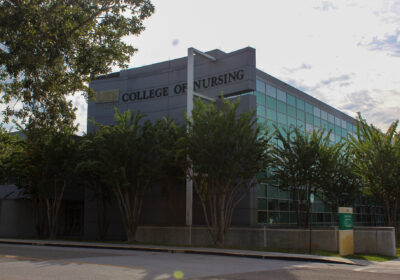Media response could inspire more mass shootings

USF students leaving flowers and other items at a candlelit vigil Friday night. Seventeen students lost their lives on Wednesday in a Parkland, Florida school shooting. ORACLE PHOTO/JOSH FIALLO
In the wake of the most recent mass shooting at Marjory Stoneman Douglas High School in Parkland, Florida, on Feb. 14 — where 17 people were killed by a former student — Everytown For Gun Safety, an organization aiming to reduce gun violence in the U.S., released a statistic that this event marks the 18th school shooting in 2018.
This statistic is particularly alarming as 18 appears to be an extremely high number of school shootings to occur in the two months since the new year began and for such a high number the only shooting that has garnered high media attention is the one at Marjory Stoneman Douglas High School. Are school shootings becoming so common that media coverage is only provided when there is a high number of casualties?
Everytown For Gun Safety measures school shootings as “any time a firearm discharges a live round inside a school building or on a school campus or grounds.” Some of the 18 school shooting cases reported in 2018 did not involve any casualties or injuries and some even occurred after school hours.
For example, according to the New York Daily News, the first school shooting of 2018 happened on Jan. 3 in St. Johns, Michigan, at East Olive Elementary School, where a man died from a self-inflicted gunshot wound in the school parking lot. The school had been closed for seven months.
The next day in Seattle, a gunshot was fired into the window of New Start High School where no injuries were reported. While these shootings meet the criteria of what constitutes a school shooting, the lack of casualties or injuries involved could explain the lack of media coverage.
But what happens when extensive media coverage is only provided for mass tragedy? Paradoxically, major media coverage on mass shootings could lead to more mass shootings. According to a study by Jennifer Johnson and Andrew Joy, presented by the American Psychological Association, a “media contagion effect” occurs when media focuses mostly on profiling the gunman in a mass shooting event.
When the media contagion effect occurs, others become inspired to recreate a similar event in order to reach a similar level of fame and notoriety. Collecting demographics from six previous studies, Johnson and Joy profile a typical mass shooter as a “white, heterosexual male between the age of 20 and 50 who is depressed, socially isolated, and narcissistic.” Johnson and Joy argue that the shooter’s desire to achieve fame and notoriety is an attempt to “reclaim social capital.”
This argument could be applied to the shooter, who has been profiled as a troubled youth involved in a white supremacist group — the Republic of Florida — as confirmed by the group’s leader, Jordan Jereb. Media outlets such as the Washington Post and the New York Times debunked these claims.
Johnson and Joy state that being part of this demographic “may convey a particular vulnerability to loss of social capital and, more importantly, a belief that one has been wrongfully cheated out of one’s rightful dominant place—a white, middle class male, with all requisite privileges in American society.” The shooter’s membership to a white supremacist group emulates this particular concern.
While media coverage is important to explain large-scale tragedies, more responsible measures of reporting should be taken.
Sensationalizing the gunman in such an event gives killers an undeserved fame and possibly encourages reproductions from copy killers of similar demographics to regain social capital.
Johnson and Joy suggest that not naming the gunmen involved could potentially reduce the number of mass shootings. Media outlets should aim to explain rather than exploit these types of tragedies.
Paige Wisniewski is a junior majoring in interdisciplinary sciences.






